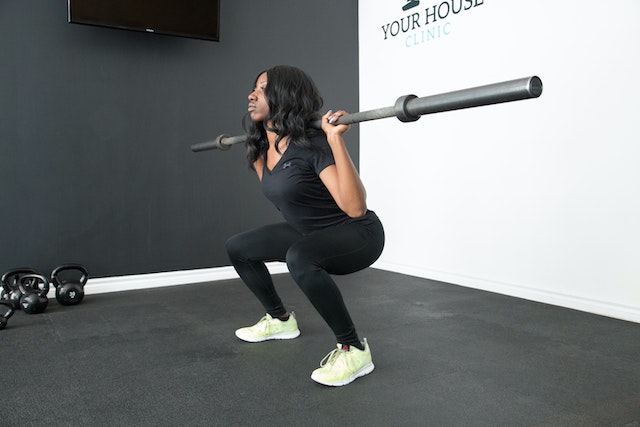The Average Rep for Squats varies from person to person. There are soo many factors to look into when finding the average reps like age, training style, gender, weight and more.
So What is the average Rep for Squats?
- For Muscle Building (8-12 reps)
- For Strength Training (3-6 reps)
- For Toning (10 reps)
- For Endurance (20-50 reps)
| Training | Squats Weight | Average Reps |
| Muscle Building | Medium | 8 – 12 reps |
| Strength Building | Heavy | 3 – 6 reps |
| Toning | Light | 10 reps |
| Endurance | Light | 20 – 50 reps |
- Must Read :- Average Squats for 14 year old
- Must Read :- Average Squats for 15 year old
- Must Read :- Average Squats for 16 year old
- Must Read :- Average Squats for 17 year old
- Must Read :- Average Squats for 18 year old
List of muscle used when Suqatting
- quadriceps
- hamstrings
- glutes
- abdominals
- calves
Importance of Barbell Squats

The barbell back squat is a famous compound exercise that focuses on making the lower-body muscle groups and general muscle. It is an excellent way to start a leg day and is a reputable foundation for a lower-body training program. The squat is a competitive lift in the sport of powerlifting but is also a traditional measure of lower-body muscles.
Barbell squats are one of four useful barbell exercises a person can do. Squatting is a primary activity that humans have been performing since creation. By gradually burdening a barbell with weight and adequately squatting, you can get finer at squatting. Barbell squats are the only workout that straight supports your posterior chain muscles. These are the glutes, the hamstrings, and the adductors.
These muscles are answerable for creating what is called hip drive. To apprehend hip drive, you need to think of a football lineman who bursts out of his posture when the ball is cracked. This is what is implicated in getting out of a chair or off a toilet. No, squats presumably won’t turn you into an NFL all-pro left tackle. But they will make you more effective at getting out of a chair or off a toilet.
A more powerful posterior chain muscle group will also improve your capacity to pull, jump, push, and will enhance any activity involving your lower body. When you accurately perform a barbell squat, the muscles you support will also enhance your equilibrium and mobility. Remember, having more powerful and more effective muscles rewords into a stronger and more efficient you. And the inverse is also true. More vulnerable and less efficient muscles mean a weaker and less efficient you.
How to perform Squats

- Start with the barbell endorsed on top of the traps. The chest must be up and the head fronting forward. Embrace a hip-width posture with the feet turned out as needed.
- Dismount by bending the knees, abstaining from moving the hips back as much as feasible. This demands that the knees travel forward. Confirm that they stay parallel with the feet. The purpose is to keep the body as erect as you can.
- Continue down, maintaining the weight on the front of the heel. At the moment the upper legs reach the lower legs change the motion, moving the weight upward.
How to improve your squats?

There are some safety precautions that you must keep in mind when doing squats are discussed here. Only decline yourself as far as you can easily do. When you start to feel distressed in your hips or knees, stop and use that as your endpoint.
Ensure you have stable ground. Most squat exercises demand you to begin with your feet a little wider than shoulder-width apart. Using a thinner posture lets you target the outer thigh muscles, but it also reduces the strength of your floor and puts extra stress on your knees.
Keep your eyes forward. While it may appear natural to look down when performing a squat, you need to keep your eyes straight ahead. To do this, you need to pick a place in front of you to concentrate on. This may help you maintain your neck in an unbiased position. Keep your stance upright. Evade rounding your back or shoulders. Concentrate on keeping your spine straight and in an impartial position, with your head neutral, not looking up or down.
Only lift what you can handle. Avoid going heavy with a weight if your state can’t bear it. You will benefit more from the squat if you manage it with good form than you will if you lift too much weight. Apart from this, lifting too much weight can weaken your lower back, hips, and knees, which can direct to damages. Activate your body. Keep your body muscles triggered throughout the whole movement. Think of these muscles as your inner weight belt that carries everything in its position.
Benefits of Squats
Professionals consider the squat as one of the most useful exercises for improving athletic routine. It is moderately comfortable for most people to perform because it does not demand any equipment.
The specific advantages to the body include:
- strengthening the muscles in the legs that includes the calves, quadriceps, and hamstrings
- supporting the knee joint
- burning fat and boosting weight loss
- maintaining the lower back
- enhancing flexibility in the lower body

